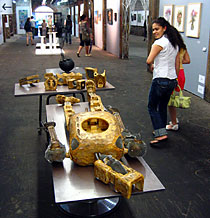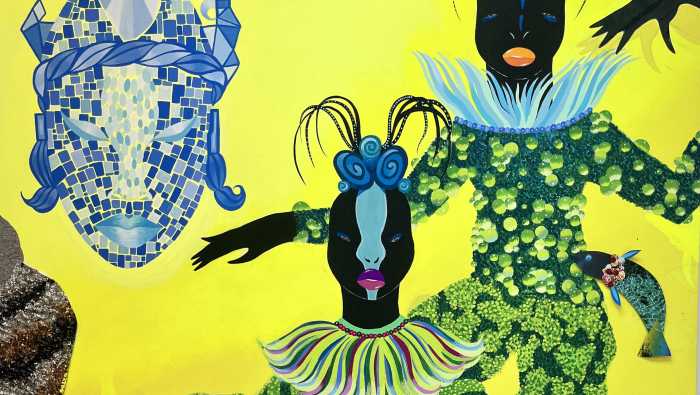"Transformations," the 2006 edition
of the Pier Show coordinated by the Brooklyn Waterfront Artists
Coalition in Red Hook, features the work of hundreds of local
artists. A few of the pieces are well worth the trip, but visitors
will have to sift through a lot of material to find the gems,
such as Janice Mauro and Joanne Pagano Weber’s narrative installation,
"The Man From Brancheville."
An abundance of clown paintings, photo-shopped gag shots, hippie
kitsch and cloying, gift-shoppy floral dioramas, all optimistically
priced, lie in wait to torment art lovers at the Pier Show.
For those who soldier on, there are rewards: Clarissa Talve’s
photographs are reminiscent of Diane Arbus, as is David Vigon’s
single, arresting large-scale photograph of a boy grimacing in
a beachfront tourist-trap parking lot; while Melanie Martinho’s
exquisite paper collages have a flair for the perfect accident,
not unlike that of Dadaist Kurt Schwitters.
Luis Rojas’s allegorical religious paintings stand out from the
crowd, resplendent with beads, sequins and embroidery: "Transformation
of Lucifer: ’The Kiss’ " is both boldly visionary and obsessively
naive.
The biggest seller of the show is abundantly clear: Ed Rosko’s
Lichtenstein-esque, screen-printed metal reliefs had already
been plundered by collectors by the end of opening day.
The unexpected is a rarity in this Pier Show; one notable exception
is the aforementioned installation by Mauro and Pagano Weber,
"The Man From Brancheville." It’s constructed like
a natural history museum exhibit from the distant future.
The figure of "the Man," sculpted from grubby Styrofoam
inserts and found objects, reclines lugubriously on a gurney-like
table, appearing at first glance to be a sort of science fair
project, perhaps a high school student’s failed attempt at robotics.
"The Man," it turns out, is the subject of research
by fictional NYU archaeology professor Dr. Ixton Verton, circa
6000 AD. The "remains" on the exam table are accompanied
by associated "artifacts" and a wall of detailed drawings
and curatorial explanations.
The "Man From Brancheville," states one text, is one
of the doomed "Elites," a class of corporate technocrats
who "rose to supreme power, first by taking over world governments,
which they considered impediments to business." Protected
by "contexturon," an indestructible metal alloy that
eventually destroys everything it touches, the Elites "survived"
disastrous environmental conditions that wiped out all the Earth’s
cites. They perpetuated themselves as DNA chips, digital personalities
that could randomly access pre-recorded memories and experiences.
The Elites gradually constructed artificial bodies and encased
them in contexturon, and mega DNA chips were housed in the "brain"
(groin area) of each.
A human wannabe from a lost civilization, "The Man From
Brancheville" is "studied" in the richly detailed
technical drawings explaining its functional parts. The mysterious
Styrofoam "artifacts" that lie alongside the figure
are identified as "Dog," "Maid," "Playstation"
and so on, also explained in detail in the drawings. A map shows
us the world of the Elites where vast continental regions are
given labels like "Waste Management," "Microsoft
Sea" and "Time Warner Management."
The installation is the first collaborative project by Pagano
Weber, an artist, writer and designer, and sculptor Mauro. The
two artists "met in the first hour of the first class on
the first day" at Fashion Institute of Technology, says
Pagano Weber, "and we’ve been friends ever since."
Thirty years later, when given an opportunity to create an installation
in a sepulcher-like space in a Branchville, Conn. gallery, the
two friends decided to "do something fun together."
Mauro began by constructing the contents of a futuristic tomb
discovery: the figure of the man and the artifacts. Each object
Mauro created was then carefully drawn and labeled by Pagano
Weber, who also wrote the back-story and texts for the installation.
According to Pagano Weber, the artists didn’t set out to include
social comment in the piece.
"Whether you intend it or not, the issues that are under
your skin will come out," she says.
"There was a lot of controversy at the gallery, in the community"
of Branchville at the unveiling of the installation, says Mauro.
One local man was offended by the class politics of the piece,
Mauro claims, and shouted: "If it wasn’t for us, you people
wouldn’t have a way of life."
"It turned out to be more serious than we ever thought,"
says Pagano Weber. "[But] we can’t take ourselves too seriously,
even though it’s a serious issue. My idea isn’t any more important
than anybody’s; it’s a conversation no matter which side of the
argument you’re on. If the piece makes you have that conversation,
I’m doing something."
The political edge to the humor in "The Man From Brancheville"
might offend those who prefer their art cleansed of opinion or
social agenda. But for those in search of an art-viewing experience
that rewards investigation, Mauro and Pagano Weber have contributed
a unique and engaging piece to this season’s BWAC offerings.
"Transformations: The Brooklyn Waterfront Artists Coalition’s
14th Pier Show" is on view Saturdays and Sundays, from 1
pm to 7 pm, through June 18 on the pier at 499 Van Brunt St.
in Red Hook. Admission is free. For more information, call (718)
596-2507 or visit www.BWAC.org.

























